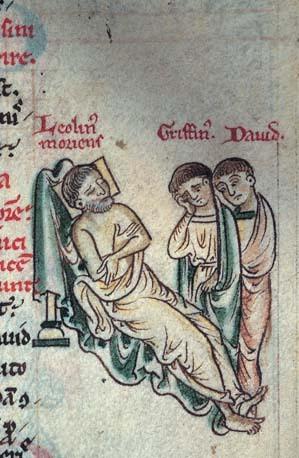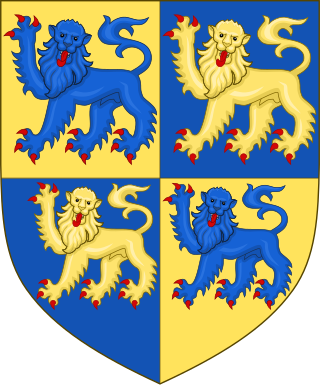
Llywelyn ap Gruffudd, sometimes written as Llywelyn ap Gruffydd, also known as Llywelyn the Last, was the native Prince of Wales from 1258 until his death at Cilmeri in 1282. Llywelyn was the son of Gruffydd ap Llywelyn Fawr and grandson of Llywelyn the Great, and he was one of the last native and independent princes of Wales before its conquest by Edward I of England and English rule in Wales that followed, until Owain Glyndŵr held the title during the Welsh Revolt of 1400–1415.

Llywelyn the Great was a King of Gwynedd in north Wales and eventually "Prince of the Welsh" and "Prince of Wales". By a combination of war and diplomacy he dominated Wales for 45 years.

The Kingdom of Gwynedd was a Welsh kingdom and a Roman Empire successor state that emerged in sub-Roman Britain in the 5th century during the Anglo-Saxon settlement of Britain.

The Treaty of Montgomery was an Anglo-Welsh treaty signed on 29 September 1267 in Montgomeryshire by which Llywelyn ap Gruffudd was acknowledged as Prince of Wales by King Henry III of England. It was the only time an English ruler recognised the right of a ruler of Gwynedd over Wales. Llywelyn's grandfather Llywelyn the Great had previously laid claim to be the effective prince of Wales by using the title "Prince of Aberffraw, Lord of Snowdon" in the 1230s, after subduing all the other Welsh dynasties. Likewise Llywelyn's uncle, Dafydd ap Llywelyn, claimed the title of Prince of Wales during his reign from 1240 to 1246. However, Llywelyn's supremacy in the late 1260s forced recognition of his authority in Wales by an English Crown weakened by internal division.

The Principality of Wales was originally the territory of the native Welsh princes of the House of Aberffraw from 1216 to 1283, encompassing two-thirds of modern Wales during its height of 1267–1277. Following the conquest of Wales by Edward I of England of 1277 to 1283, those parts of Wales retained under the direct control of the English crown, principally in the north and west of the country, were re-constituted as a new Principality of Wales and ruled either by the monarch or the monarch's heir though not formally incorporated into the Kingdom of England. This was ultimately accomplished with the Laws in Wales Acts 1535–1542 when the Principality ceased to exist as a separate entity.
Gwenllian of Wales or Gwenllian ferch Llywelyn was the daughter and only child of Llywelyn ap Gruffudd, the last native Prince of Wales. Gwenllian is sometimes confused with Gwenllian ferch Gruffudd, who lived two centuries earlier.
Owain ap Gruffudd was brother to Llywelyn ap Gruffudd and Dafydd ap Gruffudd and, for a brief period in the late 1240s and early 1250s, ruler of part of the Kingdom of Gwynedd.

Llywelyn's coronet is a lost treasure of Welsh history. It is recorded that Llywelyn ap Gruffudd, Prince of Wales and Lord of Aberffraw had deposited this crown and other items with the monks at Cymer Abbey for safekeeping at the start of his final campaign in 1282. He was killed later that year. It was seized alongside other holy artefacts in 1284 from the ruins of the defeated Kingdom of Gwynedd. Thereafter it was taken to London and presented at the shrine of Edward the Confessor in Westminster Abbey by King Edward I of England as a token of the complete annihilation of the independent Welsh state.

Castell y Bere is a Welsh castle near Llanfihangel-y-pennant in Gwynedd, Wales. Constructed by Llywelyn the Great in the 1220s, the stone castle was intended to maintain his authority over the local people and to defend the south-west part of the princedom of Gwynedd. In 1282, war with Edward I of England resulted in the death of Llywelyn's grandson, Llywelyn ap Gruffudd, and Castell y Bere fell to English forces. Edward I expanded the castle further and established a small town beside it. In 1294 the Welsh leader Madog ap Llywelyn mounted a major revolt and the castle was besieged and apparently burnt. Edward did not repair it and it became ruined. Today it is in the hands of Cadw and operated as a tourist attraction.
Gruffydd ap Gwenwynwyn was a Welsh king who was lord of the part of Powys known as Powys Wenwynwyn and sided with Edward I in his conquest of Wales of 1277 to 1283.
Llywelyn ap Dafydd (c.1267–1287), potential claimant to the title Prince of Gwynedd, was the eldest son of Dafydd ap Gruffydd, the last free ruler of Gwynedd, and his wife Elizabeth Ferrers.
Perfeddwlad or Y Berfeddwlad was an historic name for the territories in Wales lying between the River Conwy and the River Dee. comprising the cantrefi of Rhos, Rhufoniog, Dyffryn Clwyd and Tegeingl. Perfeddwlad thus was also known as the Four Cantrefs.
This article is about the particular significance of the century 1201–1300 to Wales and its people.

Wales in the High Middle Ages covers the 11th to 13th centuries in Welsh history. Beginning shortly before the Norman invasion of the 1060s and ending with the Conquest of Wales by Edward I between 1278 and 1283, it was a period of significant political, cultural and social change for the country.

The history of Gwynedd in the High Middle Ages is a period in the History of Wales spanning the 11th through the 13th centuries. Gwynedd, located in the north of Wales, eventually became the most dominant of Welsh polities during this period. Contact with continental courts allowed for Gwynedd to transition from a petty kingdom into an increasingly sophisticated principality of seasoned courtiers capable of high level deplomacy and representation; not only with the Angevine kings, but also the king of France and the Papal See. Distinctive achievements in Gwynedd include further development of Medieval Welsh literature, particularly poets known as the Beirdd y Tywysogion associated with the court of Gwynedd; the reformation of bardic schools; and the continued development of Cyfraith Hywel. All three of these further contributed to the development of a Welsh national identity in the face of Anglo-Norman encroachment of Wales.

The Royal House of Aberffraw was a cadet branch of the Kingdom of Gwynedd originating from the sons of Rhodri the Great in the 9th century. Establishing the Royal court of the Aberffraw Commote would begin a new location from which to rule Wales. The cadet branch achieved the recognised titles of Prince of Wales, King of Wales and were sometimes named King of Aberffraw.

Dafydd ap Gruffydd was Prince of Wales from 11 December 1282 until his execution on 3 October 1283 on the orders of King Edward I of England. He was the last native Prince of Wales before the conquest of Wales by Edward I in 1283 and English rule in Wales that followed, until Owain Glyndŵr held the title during the Welsh Revolt of 1400–1415.

The conquest of Wales by Edward I took place between 1277 and 1283. It is sometimes referred to as the Edwardian Conquest of Wales, to distinguish it from the earlier Norman conquest of Wales. In two campaigns, in 1277 and 1282–83, respectively, Edward I of England first greatly reduced the territory of Llywelyn ap Gruffudd, and then completely overran it, as well as the other remaining Welsh principalities.

The Welsh crown jewels are the royal relics of the Kingdom of Gwynedd that were stolen by Edward I of England following the death of Llywelyn ap Gruffudd, Prince of Wales, in Cilmeri.










